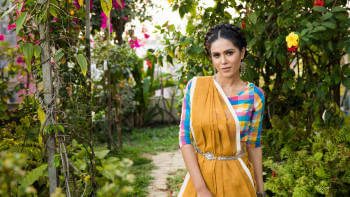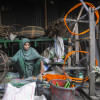As the year winds down, Bangladesh's neighbourhoods come alive with the anticipation of yet another wedding season. Homes are adorned, alleys sparkle with lights, and the air buzzes with excitement as families prepare for celebrations. In our search for vibrant sarees and panjabis, it's worth pausing to consider the hands that weave these garments.
The country's taant (handloom) industry — a vital piece of the nation's cultural and economic fabric – is currently struggling under the weight of economic challenges. This season, our support for these artisans, who breathe life into traditional garments, is more important than ever.
A labour of love and heritage
Bangladesh's taant industry has deep roots, extending back through centuries and interwoven with the nation's cultural identity. The industry's resilience has withstood wars, economic downturns, and political upheaval but today it faces a more insidious threat — consumer disinterest and limited local support.
Kutub Uddin, a weaver at Benaroshi Polli in Mirpur 10, who has been weaving since his childhood, reflects on how his career began out of necessity in the years following Bangladesh's independence. His family, hit by poverty, relied on weaving to survive.
Over the decades, he watched as demand for handloom Benaroshi sarees fluctuated, with recent years seeing a noticeable decline. "Ten or twelve years ago, Benaroshi sarees were in high demand," he says. "But now, the industry is in crisis."
Although demand rises slightly during the wedding season, imported sarees, especially from India, flood the market and divert customers away from local artisans.

The weaver explains that creating a Benaroshi saree can take anywhere from a few weeks to several months, depending on its intricacy. In the past, he worked alongside a team where each person specialised in a step of the process, from twisting threads to making zari. However, many of his former colleagues have left the industry, taking up jobs as rickshaw pullers or in restaurants to support their families.
Today, local weavers like him are overshadowed by cheaper, imported alternatives, which deprive Bangladesh's taant industry of the support it needs to survive.
The process of creating a handloom saree is labour-intensive and requires immense skill, yet the artisans are paid modestly for their work. A weaver in Chapai Nawabganj explains that they are paid per yard, with a single weaver managing to produce three to four yards on a good day.
Each piece they create is a labour of love, meticulously crafted to perfection but it's also a product of rising material costs. The price of threads, dyes, and silk has increased significantly over the years, squeezing profit margins and leaving weavers struggling to sustain their craft.
This weaver points out that while one might expect wedding season to boost demand, reality paints a different picture. Customers often overlook locally made handloom sarees in favour of imported options, limiting local weavers' access to new business.
"We think wedding season will bring in orders, but mostly we only see demand rise around Eid," he explains, "While for weddings, people often look to India or other countries."
Economic hardships and limited support
For many artisans, the art of weaving is a family tradition, with skills passed down from generation to generation. However, the economic realities of weaving have made it harder for artisans to encourage their children to continue in their footsteps.
Sandip Basak, a Tangail saree seller describes how increasing production costs and low sales affected his business during the recent puja season, a time they hoped would bring a surge in demand.
Instead, sales were disappointing, and many artisans now face the prospect of leaving the handloom industry altogether. "If this trend continues, we might not have anyone left to pass on this knowledge," he notes.
This loss of generational knowledge is one of the most significant threats facing the handloom industry. If young people do not see a viable future in weaving, they will pursue other professions, leading to the disappearance of traditional techniques that have been refined over centuries.
Md Sajib, a Jamdani weaver, once serving a steady base of clients, finds himself in a difficult position now, as even his most loyal clients have begun to cancel orders due to rising prices. He has reached out to banks to secure a loan to sustain his business, only to be denied.
"Banks don't want to support us because they believe the Jamdani market is struggling," he explains, feeling the lack of support keenly. For him, the future of the taant industry relies not only on customers but also on financial backing, so artisans can continue their work and keep the craft alive.
Weavers' calls for financial assistance are more than pleas for personal relief — they reflect a need to protect an industry deeply connected to Bangladesh's identity. Without support, they are at risk of losing not only their income but a part of their heritage.
Supporting our weavers this wedding season
The wedding season offers an opportunity for each of us to make a difference. By choosing to buy locally crafted handloom sarees, we directly support the artisans who sustain this age-old tradition.
One weaver reminds us, "The sarees of our country – whether Jamdani, Benaroshi, or cotton — are unique. People should understand that, so weavers like me can continue our work."
Let's show our appreciation for their skill and dedication because when we support our weavers, we weave a more sustainable, culturally rich future for Bangladesh.
Photo: Hadi Uddin
Model: Najma Chisti and Shanila Mehjabin
Wardrobe: NOBO x Sharmin Rahman (Sharminrahmandesigns)
Mirpur Katan
Weaver: Kutub Uddin
Original Vintage Saree: Nasreen Shams
Mua: Shababa Rashid














Comments